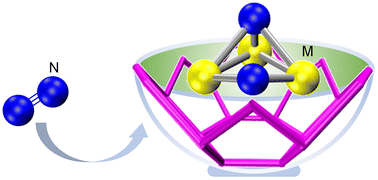Trimetallic clusters in the sumanene bowl for dinitrogen activation†
Abstract
It is of great importance to find catalysts for the nitrogen reduction reaction (NRR) with high stability and reactivity. A series of M3 clusters (M = Ti, Zr, V, and Nb) supported on sumanene (C21H12) were designed as potential catalysts for the NRR by taking advantage of the high reactivity of trimetallic clusters and the unique geometric and electronic properties of sumanene, a bowl-like organic molecule. Detailed mechanisms of N![[triple bond, length as m-dash]](https://www.rsc.org/images/entities/char_e002.gif) N bond cleavage on C21H12–M3 were investigated by DFT calculations and compared with those on bare M3 clusters. M3 in the sumanene bowl is very stable with large binding energies, which prohibits the cohesion of M3 into M6. In the bowl, M3 has a (quasi-) equilateral triangle structure with lengthened M–M bonds, which is particularly beneficial to the N2 transfer process on Ti3 and V3 clusters. The N–N bond can be dissociated by both M3 and C21H12–M3 clusters without the overall energy barriers. A blurring effect is found in which some geometric and electronic properties of different metal types become similar when M3 is supported on the substrate. Our work demonstrates that sumanene is a suitable substrate to support M3 in the activation of N2 with enhanced stability and maintained a high level of reactivity compared to bare M3.
N bond cleavage on C21H12–M3 were investigated by DFT calculations and compared with those on bare M3 clusters. M3 in the sumanene bowl is very stable with large binding energies, which prohibits the cohesion of M3 into M6. In the bowl, M3 has a (quasi-) equilateral triangle structure with lengthened M–M bonds, which is particularly beneficial to the N2 transfer process on Ti3 and V3 clusters. The N–N bond can be dissociated by both M3 and C21H12–M3 clusters without the overall energy barriers. A blurring effect is found in which some geometric and electronic properties of different metal types become similar when M3 is supported on the substrate. Our work demonstrates that sumanene is a suitable substrate to support M3 in the activation of N2 with enhanced stability and maintained a high level of reactivity compared to bare M3.

- This article is part of the themed collection: 2022 PCCP HOT Articles


 Please wait while we load your content...
Please wait while we load your content...